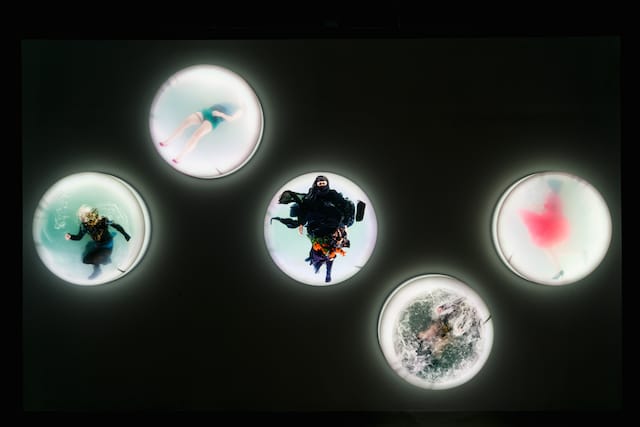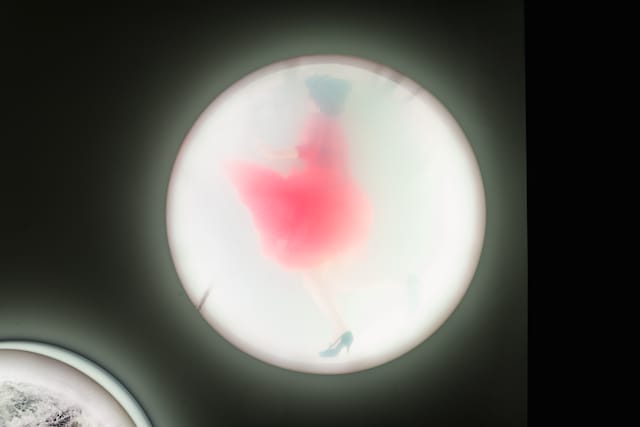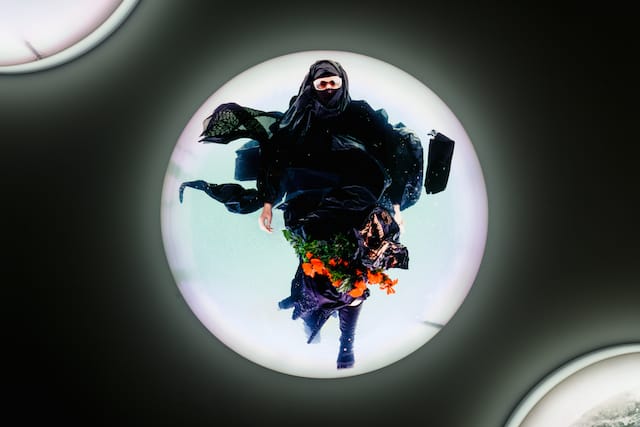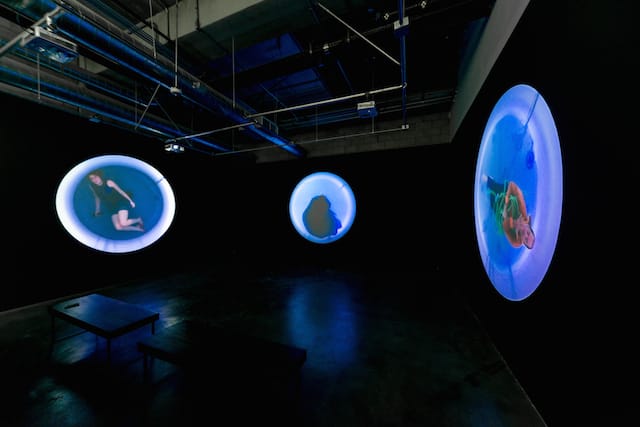An Aquatic Video Performance Immerses Us in the California Drought
LOS ANGELES — Imagine that you are trying to get dressed underwater but every time you lift your arms the water you’re wading through pulls them back down.

LOS ANGELES — Imagine you are trying to get dressed underwater but every time you lift your arms the water you’re wading through pulls them back down. Like a blinded, injured fish you want to sink into the abyss of your tank and just flounder. You can see the chlorine-blue water but can’t see through it.
Currently on view at the Pasadena Museum of California Art is artist Lars Jan’s project HOLOSCENES / Quaternary Suite, showing videos of performers Geoff Sobelle and Annie Saunders, who recently starred in the site-specific theatre piece The Day Shall Declare It, immersed in cylinders continuously flooding with water. These aquatic performances play within a video triptych and the five light circumferences. Inside the watery bubbles, the performers do everyday things such as get dressed for work, eat ramen, and make phone calls, but they struggle the entire time against the weight of this seemingly endless water supply, an ironic gesture since the end of California’s water supply is near.
There are two elements at play in Jan’s work: one local to California, and one global. From 2012–2014, California experienced the worst drought in 1,200 years. The state is running out of water and it’s curious to note that 10 percent of California water apparently goes to almond farming, while 70 percent of urban water use goes to landscaping and sprinklers.

Jan’s project also alludes to the Holoscene Epoch, the geologic time period that began around 11,500–12,000 years ago at the end of the Paleolithic Ice Age, which may be coming to an end as a result of humanity’s inevitable impact on the planet. Geologists have been debating whether we’ve already entered the Anthropocene Epoch, marked by man’s irreversible change to the earth’s biology and chemistry. Until then, we float in an in-between zone, as expressed in the graceful, gorgeous visual that Lars Jan’s project provides.
When we think of water, we’re more likely to visualize people swimming in a lake or surfing the ocean waves, a car undergoing a thorough cleansing, or a person taking a morning shower. Humans are watery creatures. Babies are born 75 percent water, and humans become progressively drier as they age with adult men at 60 percent water, women at 55 percent, and the elderly at about half water. Dropping below that percentage would mean progressive burnout.
Lars Jan is interested in big questions about man’s relationship to the environment, culture, and technology. In 2012, he staged the performance piece “Abacus” at REDCAT in downtown Los Angeles, a project dedicated to understanding people’s interactions with digital and computer screens, particularly how they affect our perceptions of each other. His work is both performative and visually immersive, a combination that works well when discussing broader sociocultural moments in a socially networked, global culture.
In the HOLOSCENES project, dipping below the surface of the water for too long would result in passing out, and possibly drowning. The performers in Jan’s videos don’t drown, but the plethora of water makes it difficult for them to physically move. The immersion is almost forceful or violent, albeit grabbing our attention quietly, like a slowly cresting wave that all of a sudden crashes into us.
The public is hardly made aware of the extreme drought, other than the tepid suggestion to start conserving water and stop watering lawns. It’s especially prevalent in Pasadena, where this exhibition is on view. Jan’s project paints individual aquatic vignettes equal parts beautiful and surreal that, like our fatal environmental impact, cannot be forgotten. If anything, it leaves so much wonder as to incite terror, not offering any types of solutions but rather awakening one to the reality of our times.


Lars Jan: HOLOSCENES / Quaternary Suite continues at the Pasadena Museum of California Art (490 East Union Street, Pasadena, California) through May 31.




